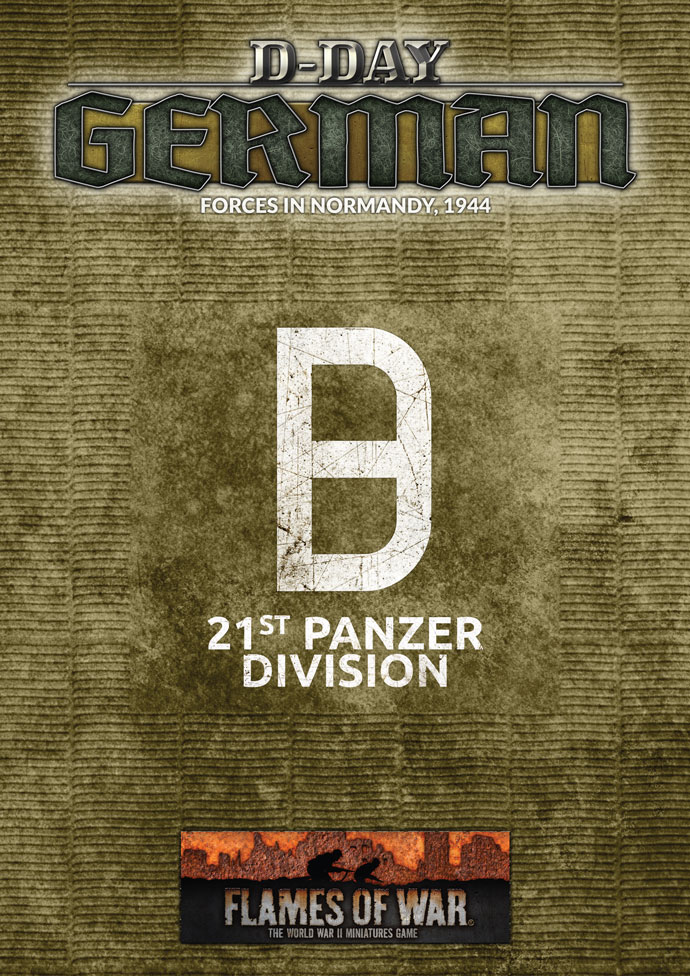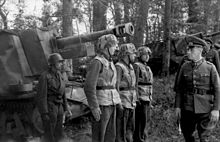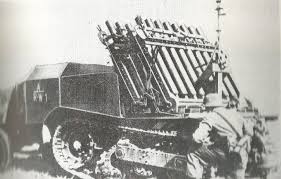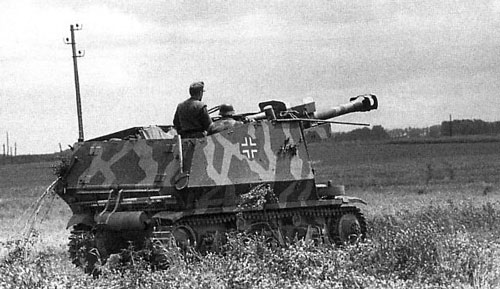|
|
 |
|
|
Baustab Becker and 21. Panzer-Division in Normandy
|

|
Baustab Becker and 21. Panzer-Division in Normandy
with Michael McSwiney
In early May, 1943 after the destruction of the original 21. Panzer-Division in Africa, Hitler ordered the upgrade of a mobile brigade forming in France, Schnelle Brigade West, to a full panzer division and renamed it 21. Panzer-Division. Veterans of the original division who had not been killed or captured were made available and formed the core of the new formation. To avoid confusion, the division was officially referred to as 21. Panzer-Division “Neu” (for “new”) until 1 January 1944.
Click here to see the 21st Panzer Division in the online store...
|
|
Unfortunately, this new division was being raised at a time where materiel was in short supply as the Wehrmacht was gearing up for Unternehmen Zitadelle, the attack on the Kursk Salient in the Soviet Union. A German High Command order on 27 June 1943 expressly forbade 21. Panzer-Division from requisitioning equipment and vehicles (apart from communications gear) from official German stocks. They were instead to draw equipment and vehicles from the stockpiles of French equipment available locally. Initial deliveries of indigenous German equipment were therefore scarce, amounting to only 24 PaK43 8.8cm anti-tank guns and 12 leichte Feldhaubitze 10.5cm howitzers.
|
|

|
|
Fortunately for the division, they had at their disposal Hauptmann (later Major) Alfred Becker. A veteran of the Great War, Becker earned a doctorate in mechanical engineering after returning from that conflict, and would put it to good use during the Second World War. German encounters with the T-34 and KV-1 tanks in the Soviet Union created shockwaves throughout the Wehrmacht and created a critical need for not only more powerful anti-tank guns, but mechanised chassis to allow their more rapid and flexible deployment. In order to provide mobility to the excellent 7.5cm PaK 40 anti-tank gun, Becker had initially mated the gun to the Lorraine 37L tracked carrier creating the Marder I. This conversion, along with several others convinced Hitler to give Becker a free hand in developing the existing stocks of French equipment into useful armoured fighting vehicles.
|
|
To facilitate his work, Becker set up a workshop facility just outside of Paris at Maison-Lafitte which became known as “Baustab Becker”. The development and conversion process was hampered somewhat by the poor state of the captured stocks of French equipment, which were essentially obsolete by 1943 standards and had not been maintained. Each vehicle was individually reviewed and graded based on its overall condition. Only those in reasonable shape would be converted to new vehicles, while those in the worst condition would donate any usable parts as spares.
|

|
|
At this facility, many conversions were carried out which would supply not only 21. Panzer-Division, but several other German formations as well. Becker worked closely with Alkett to fabricate specially-designed replacement superstructures for the French AFVs which would then be installed at Baustab Becker. All total, the facility would produce almost 450 armoured vehicles during the war including:
- 184 Marder I
- 96 15 cm sFH13/1 (Sf) auf Geschuetzwagen Lorraine Schlepper (f)
- 36 10.5 cm leFH 18M auf Geschuetzwagen Lorraine Schlepper (f)
- 24 7.5cm PaK40 auf Hotchkiss37 10.5 cm leFH 18M auf Hotchkis
|
|
In addition to the self-propelled guns and Sturmgeschütz, Becker made extensive use of French half-tracked vehicles which, like their fully-tracked counterparts, had largely been left to rust since the French armistice in 1940. These included many examples of both the Somua MCG and Unic P107. The former was most often used to create self-propelled rocket launchers though there was an anti-tank variant as well, while the latter was modified for use as a troop transport filling the same tactical role as the ubiquitous Sd. Kfz.251 half-track.
|
|

|
The self-propelled rocket launchers based on the MCG half-track would provide direct support for 21. Panzer-Division during the Normandy campaign. One design utilized the 8cm Raketen-Vielfachwerfer, which was essentially a German copy of the Soviet BM-8 Katyusha launcher. Another design used was the Reihenwerfer, which consisted of 16 captured Brandt Mle 27/31 mortars mounted on a framework in two rows of eight. The resulting barrage mortar was then mated to the MCG chassis in a 360 degree mount with controllable elevation. When fired the mortars would launch in rapid succession providing a saturation bombardment to the target area. Sixteen of the adaptable little MCG chassis were also used to mount the 7.5cm PaK 40 gun, creating a very potent mobile anti-tank gun.
|
|
Sturmgeschütz Abteilung 200
Because of his military record and familiarity with the equipment, Becker was tapped to command Sturmgeschütz Abteilung 200 which consisted of several batteries of his 7.5cm PaK and 10.5cm le F. H. conversions of the Hotchkiss tank. In early 1944, Becker’s unit along with the rest of the division was deployed north to Brittany, though Field Marshal Rommel, in command of German forces in Normandy, would later move the division to the region outside Caen. As his troops still lacked experience, Becker worked hard to both train the men and ensure that the tactics used played to the strengths of their unique vehicles in anticipation of the fighting ahead.
|
|
Available references disagree as to exactly how Becker ultimately organized his formation when fighting commenced in June 1944. Some references indicate that Becker fielded four batteries, each consisting of four 7.5cm and six 10.5cm armed Hotchkiss. However, when Rommel inspected Becker’s unit in May 1944, he noted five batteries, each armed with six 7.5cm and four 10.5cm armed Hotchkiss, with the six 7.5cm Hotchkiss in two separate platoons. However, if the production number of 24 7.5cm armed Hotchkiss is accurate, the five-battery formation described above is impossible as there would not have been 30 of the 7.5cm armed Hotchkiss available. In all accounts the 7.5cm Hotchkiss were used exclusively in a direct-fire role, while the 10.5cm Hotchkiss could be used either in direct fire or could perform indirect bombardments of more distant enemies.
|
|
However the Abteilung was organized, the fact remains when the Allies invaded the Normandy beaches on 6 June 1944, 21. Panzer-Division was the only armoured unit to move toward the beaches in accordance with Rommel’s designed defensive plan. Becker’s Sturmgeschütz would not see actual combat until 9 June when three batteries provided support for 125. Panzergrenadier-Regiment. Both the 7.5cm and 10.5cm Hotchkiss proved devastating to Allied (mostly British) tanks in these early engagements.
|

|
|
As the fighting went on in Normandy, the Germans desperately tried to keep the Allied forces pinned into the Normandy beachhead. Becker’s Abteilung was incorporated into “Kampfgruppe Luck” under then command of Hans von Luck. In addition to the Sturmgeschütz Abteilung, the battle group included not only Luck’s 125. Panzergrenadier-Regiment, and modern armoured support in the form of Panzer IV’s from 22. Panzer-Regiment and the vaunted Tiger I from 503 Schwere Panzer-Abteilung. As fate would have it, this particular battle group found itself squarely in the path of British Field Marshal Montgomery’s Operation Goodwood, which was designed to break the Normandy stalemate returning initiative to the Allies.
|
|

|
On 18 July 1944, prior to launching the ground forces, the Allies conducted a devastating preliminary bombardment consisting of over 2000 bombers carpet bombing forward defensive lines followed by a 30-minute naval and artillery barrage. Despite the severity of the bombardment, Luck was able to mount a coordinated defence along his sector of the front. Under Becker’s direct command Sturmgeschütz Abteilung 200 would engage the advancing British from concealed positions, and would then relocate before they could be tracked down by surviving elements.
|
|
The advancing British 11th Armoured Division would lose over 100 tanks that day – many to Becker’s self-propelled guns. The delaying tactics worked long enough for German reinforcements to be brought forward and stabilize the line.
|
|
Sturmgeschütz Abteilung 200 would see action against the British again when they launched Operation Bluecoat, but after this battle the unit was severely weakened through attrition. The formation would ultimately be destroyed during the Battle of the Falaise Pocket. Becker himself would be wounded on 1 August 1944, but managed to escape the pocket. Becker was again forced to flee on 3 September when he was nearly captured by resistance forces at Fosses-la-Ville. He would ultimately be captured in Alsace in December 1944.
~Michael
|
|
|
|